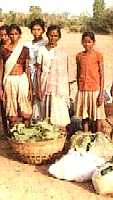DESCRIPTION: It is an evergreen, semi-evergreen or deciduous tree or shrub up to 25 m, and 1.9 m girth. The bark is pelican in colour, exfoliating in rectangular scales. The primary root is long, thick and fleshy at first, afterwards woody, greyish, often swollen in upper part near ground level. Leaves opposite or alternate and coriaceus, up to 35 cm long. USE: The fruits and powdered seeds are sold in local markets and eaten. Leaves are used as fodder and wood as timber and fuel. The seeds can be intoxicating; they have been prescribed in India as a cure for mental disorders, nervous breakdowns and palpitations of the heart. The fruits have a cooling and an astringent effect. Dried flowers are reportedly useful in urinary, skin and blood diseases. The bark is astringent; its decoction is used in diarrhoea. It is often found along field boundaries. GROWING PERIOD: Perennial. COMMON NAMES: Tendu, Balai, Tumki. FURTHER INF: It is shade tolerant in youth but later it demands light. It is drought and frost hardy but sensitive to waterlogging. It is normally found in a dry deciduous forest. Common throughout India. It is a widely distributed and tolerant species regarding soil requirements. It grows on poor denuded soils, hot and dry hill slopes, stony soils with quartzite, shale and sandstone, and also heavy clays. It however attains best growth and development on loose, porous soils in cool and moist sheltered valleys where it tends to be gregarious.
|
